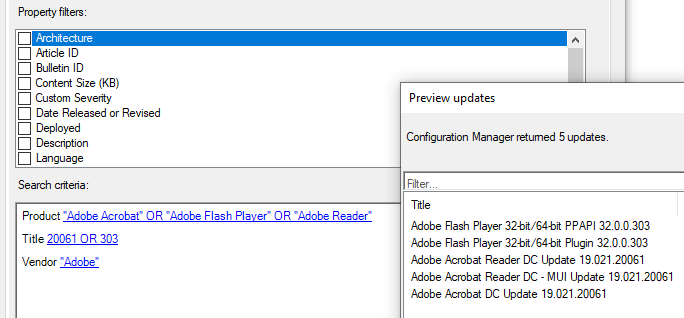Search the Community
Showing results for tags 'Automatic Deployment Rules'.
-
Hello all, I've successfully gotten 3rd party software updates working with ADR's, however, I was wondering if there way to remove Adobe Acrobat / Reader 3rd party updates that I no longer need published? If there is a way great, if not is there a way to not have to continually adjust my ADR as n...
-
I recently went through the trouble of configuring the use of Windows 10 Servicing Plans only to discover that they are close to redundant. Servicing Plans (SP) are literally Automatic Deployment Rules (ADR) which has some different options. You could achieve something almost identical using ADRs on...
-
- automatic deployment rules
- servicing plans
-
(and 1 more)
Tagged with:
-
We are in an SCCM 2012 Windows 7 environment and would like to use Automatic Deployment Rules to deploy updates. I have worked out a strategy of using the Custom Severity to allow us to manually choose which updates we want to apply as well as creating multiple rules for multiple locations to sprea...
-
This is actually pertaining to SCCM 2012 R2 but I'm sure this would apply to SCCM 2012 as well. I'm trying to determine how SCCM handles scenarios where you have two or more software update deployments, and each deployment is configured to deploy to a different collection, and one or more clients a...
- 6 replies
-
- Configuration Manager 2012 R2
- Assets and Compliance
- (and 2 more)
-
Hello, The guy the use to do the server updates retired and my boss would like to utilize SCCM 2012 to do the updates. They are currently getting there updates from WSUS and group policy. He has specific policies setup to restart specific servers at certain times of the day according to what w...
- 1 reply
-
- Software Updates
- Windows Updates
- (and 6 more)
-
Hello All, I got a quick question on the behaviour of Software Update Groups. By folloiwing the Part 6. Deploying Endpoint Protection Role... I have created the following: 1. The servershare for SCEP updates - \\servername\source\windowsupdates\EndpointProtection 2. An ADR Template which crea...
-
I am implenting ADR for patch managment and I am having a bit of a Property filter issue. I would like to create an ADR that creates monthly deployments for my patch managment that I have control on when deploying. So I have checked Create new Software Update Group under general and cleared the...
- 3 replies
-
- Automatic Deployment Rules
- ADR
-
(and 2 more)
Tagged with:


